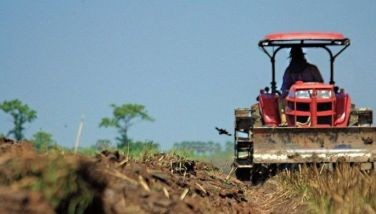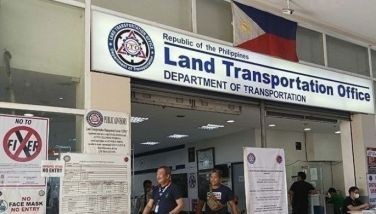Contaminated groundwater threatens tourism industr
September 16, 2001 | 12:00am
BATAC, Ilocos Norte – Groundwater resources of tourism centers and households in sand dune areas of Ilocos Norte are in real danger of being contaminated.
Government officials have expressed alarm after a scientist has determined that water coming out of the faucets of Fort Ilocandia Resort Hotel (FIRH) in Loaog City was not safe for drinking.
Researcher Floramante C. Pastor of the Mariano Marcos State University (MMSU) in this town tested samples from the hotel’s main source of drinking water and found out that they contain 900 most probable number (mpn) of Coliform organisms per 100 ml.
At this level, Pastor said the water supply of the hotel is not fit for human consumption and is only good for bathing and irrigating crops.
Otherwise known as the pride of the north, FIRH is one of the main attractions of Ilocos Norte and frequented by tourists from neighboring countries like Taiwan, Vietnam, Korea, and Mainland China, aside from local tourists. It boasts of wide sand dune areas, clean facilities, vast recreation centers, casinos, and the sprawling beaches and cottages nearby.
The MMSU researcher, who studied the land use effects on water resource of the sand dune ecosystems in Ilocos Norte, tested the water sources of residential, agricultural, and tourism centers of seven sand dune barangays of the province. These are in Paguludan in Currimao town; Suba, Nagbacalan, and Masintoc in Paoay; and Gabu, La Paz, and Calayab in Laoag City. FIRH, which is situated in the sand dunes on Calayab, was involved in the study.
The results were presented during the 13th Regional Symposium on Research and Development held at the Don Mariano Marcos Memorial State University (DMMMSU) in Bacnotan, La Union.
Results show that the FIRH water supply, and three residential wells in Brgy. Masintoc in Paoay were heavily contaminated with Coliform.
They contain as much as 900 mpn of Coliform organisms; second in the list are the two wells sampled in Brgy. Paguludan in Curimao town which showed they have 350 mpn. Four wells in Brgy. La Paz ranked third with 225 mpn.
Water sources of restaurants and cottages along the shorelines near the FIRH, too, are not safe, according to the study.
Pastor said that wells of these places contain at least 13 mpn of Coliform organisms, a figure which is still dangerous and may cause death to human beings.
Coliform is a bacterium which thrives in human, and animal wastes. It continues to live in water as long as there is human or animal waste where it gets its food from. Water sources such as artesian wells contaminated with Coliform organisms are usually built near septic tanks and in areas where there are no sanitary means of bowel disposal. Thickly-populated areas are likely to become an easy target of Coliform contamination.
The organism causes affliction to various water-related diseases such as diarrhea, fever, abdominal pain, water discharge, mucoid stool, headache, foul smell of stool, muscle cramps, body malaise, chills, low-grade fever, and vomiting, among others.
Meanwhile, groundwater in wells is one of the main sources of drinking water, especially in rural areas, because it tends to be pure and of good quality since the soil and soil microbes filter out many pollutants. However, soil and soil microbes do not degrade levels of the soil, no further cleaning could take place and the water will remain polluted for hundreds or even thousands of years.
"If these contaminants accumulate in our groundwater resources and their water reach the water systems of restaurants, hotels, and other food chains, biomagnification could be a difficult problem," the researcher said.
The MMSU researcher said that aside from FIRH, water sources of the well-known Suba Sports Complex and the Marcoses’ Malacañang of the North are also contaminated with the organism at a lower level of about 2 mpn per 100 ml of water. Wells of houses nearby are also not spared.
The situation is alarming, because many foreigners and local tourists are staying in these places for a short vacation and are using their water resource facilities.
"But still, the count is dangerous, because zero is the only figure we need to declare them safe for human consumption," Pastor said.
"If this could not be remedied, it not only endangers our visitors’ health, but also the future of the province’s tourism industry," the researcher warned.
Aside from Coliform organism, other contaminants in the 26 wells tested were nitrate-nitrogen compounds (NO3-N), carbonates (CO3), bicarbonates (HCO3), and chloride, among others.
Of the 26 wells, nine were found to have high concentrations of NO3-N compound. Their contamination ranges from 10.74 to 41.46 parts per million (ppm) which are above the safe level for potable use.
Nitrate-nitrogen is a compound which is toxic to fetus and may result in blue baby deliveries. It is also known to cause stomach cancer in adults. Records show that at the most, one member per family a year experience water-related diseases in these areas.
In terms of chloride contents, two residential wells in Brgy. La Paz are not even safe for irrigating crops. One of them is also not safe for drinking, because it contains 300 ppm of the compound which exceeded the 250 permissible level of potable use.
On the other hand, the permissible level of chloride in water used for irrigating crops is 80 ppm. This level, according to the researcher is also the desired level for fishponds, and livestock purposes.
For immediate and long term solutions to the water contamination scare, the MMSU researcher recommends the following counter measures:
1) Contaminated groundwater should be treated with either coagulation, sedimentation, filtration, and disinfection to meet the requirement set by the National Standards for Drinking Water. Chlorination, use of purifier, and boiling are other safe alternatives;
2) Efficient use of water such as avoiding its excessive use. Recycling and basic hygienic practices are not trivial tasks, but are more likely to alleviate prospective water shortage and contamination than relying solely on spectacular technical advances;
3) Water sources such as artesian wells should be installed deeper;
4) Septic tanks should be properly built away from groundwater sources;
5) Well sites should be provided with proper drainage facilities for the proper disposal and conveyance of wastewater from sources;
6) Waste from livestock feedlots should be disposed of properly because these have high fecal and organic waste content and could be potential media for microbial growth;
7) Solid waste and other decomposing matters should be properly situated and disposed of to avoid leachates to groundwater; and
8) There should be no unsealed openings such as abandoned open dug wells, because these serve as avenues of contamination.
Government officials have expressed alarm after a scientist has determined that water coming out of the faucets of Fort Ilocandia Resort Hotel (FIRH) in Loaog City was not safe for drinking.
Researcher Floramante C. Pastor of the Mariano Marcos State University (MMSU) in this town tested samples from the hotel’s main source of drinking water and found out that they contain 900 most probable number (mpn) of Coliform organisms per 100 ml.
At this level, Pastor said the water supply of the hotel is not fit for human consumption and is only good for bathing and irrigating crops.
Otherwise known as the pride of the north, FIRH is one of the main attractions of Ilocos Norte and frequented by tourists from neighboring countries like Taiwan, Vietnam, Korea, and Mainland China, aside from local tourists. It boasts of wide sand dune areas, clean facilities, vast recreation centers, casinos, and the sprawling beaches and cottages nearby.
The MMSU researcher, who studied the land use effects on water resource of the sand dune ecosystems in Ilocos Norte, tested the water sources of residential, agricultural, and tourism centers of seven sand dune barangays of the province. These are in Paguludan in Currimao town; Suba, Nagbacalan, and Masintoc in Paoay; and Gabu, La Paz, and Calayab in Laoag City. FIRH, which is situated in the sand dunes on Calayab, was involved in the study.
The results were presented during the 13th Regional Symposium on Research and Development held at the Don Mariano Marcos Memorial State University (DMMMSU) in Bacnotan, La Union.
Results show that the FIRH water supply, and three residential wells in Brgy. Masintoc in Paoay were heavily contaminated with Coliform.
They contain as much as 900 mpn of Coliform organisms; second in the list are the two wells sampled in Brgy. Paguludan in Curimao town which showed they have 350 mpn. Four wells in Brgy. La Paz ranked third with 225 mpn.
Water sources of restaurants and cottages along the shorelines near the FIRH, too, are not safe, according to the study.
Pastor said that wells of these places contain at least 13 mpn of Coliform organisms, a figure which is still dangerous and may cause death to human beings.
Coliform is a bacterium which thrives in human, and animal wastes. It continues to live in water as long as there is human or animal waste where it gets its food from. Water sources such as artesian wells contaminated with Coliform organisms are usually built near septic tanks and in areas where there are no sanitary means of bowel disposal. Thickly-populated areas are likely to become an easy target of Coliform contamination.
The organism causes affliction to various water-related diseases such as diarrhea, fever, abdominal pain, water discharge, mucoid stool, headache, foul smell of stool, muscle cramps, body malaise, chills, low-grade fever, and vomiting, among others.
Meanwhile, groundwater in wells is one of the main sources of drinking water, especially in rural areas, because it tends to be pure and of good quality since the soil and soil microbes filter out many pollutants. However, soil and soil microbes do not degrade levels of the soil, no further cleaning could take place and the water will remain polluted for hundreds or even thousands of years.
"If these contaminants accumulate in our groundwater resources and their water reach the water systems of restaurants, hotels, and other food chains, biomagnification could be a difficult problem," the researcher said.
The MMSU researcher said that aside from FIRH, water sources of the well-known Suba Sports Complex and the Marcoses’ Malacañang of the North are also contaminated with the organism at a lower level of about 2 mpn per 100 ml of water. Wells of houses nearby are also not spared.
The situation is alarming, because many foreigners and local tourists are staying in these places for a short vacation and are using their water resource facilities.
"But still, the count is dangerous, because zero is the only figure we need to declare them safe for human consumption," Pastor said.
"If this could not be remedied, it not only endangers our visitors’ health, but also the future of the province’s tourism industry," the researcher warned.
Of the 26 wells, nine were found to have high concentrations of NO3-N compound. Their contamination ranges from 10.74 to 41.46 parts per million (ppm) which are above the safe level for potable use.
Nitrate-nitrogen is a compound which is toxic to fetus and may result in blue baby deliveries. It is also known to cause stomach cancer in adults. Records show that at the most, one member per family a year experience water-related diseases in these areas.
In terms of chloride contents, two residential wells in Brgy. La Paz are not even safe for irrigating crops. One of them is also not safe for drinking, because it contains 300 ppm of the compound which exceeded the 250 permissible level of potable use.
On the other hand, the permissible level of chloride in water used for irrigating crops is 80 ppm. This level, according to the researcher is also the desired level for fishponds, and livestock purposes.
1) Contaminated groundwater should be treated with either coagulation, sedimentation, filtration, and disinfection to meet the requirement set by the National Standards for Drinking Water. Chlorination, use of purifier, and boiling are other safe alternatives;
2) Efficient use of water such as avoiding its excessive use. Recycling and basic hygienic practices are not trivial tasks, but are more likely to alleviate prospective water shortage and contamination than relying solely on spectacular technical advances;
3) Water sources such as artesian wells should be installed deeper;
4) Septic tanks should be properly built away from groundwater sources;
5) Well sites should be provided with proper drainage facilities for the proper disposal and conveyance of wastewater from sources;
6) Waste from livestock feedlots should be disposed of properly because these have high fecal and organic waste content and could be potential media for microbial growth;
7) Solid waste and other decomposing matters should be properly situated and disposed of to avoid leachates to groundwater; and
8) There should be no unsealed openings such as abandoned open dug wells, because these serve as avenues of contamination.
BrandSpace Articles
<
>
- Latest
Latest
Latest
March 4, 2024 - 3:32pm
By Ian Laqui | March 4, 2024 - 3:32pm
March 4, 2024 - 2:12pm
By Kristine Daguno-Bersamina | March 4, 2024 - 2:12pm
February 17, 2024 - 2:31pm
February 17, 2024 - 2:31pm
February 13, 2024 - 7:24pm
By Gaea Katreena Cabico | February 13, 2024 - 7:24pm
February 13, 2024 - 7:17pm
By Ian Laqui | February 13, 2024 - 7:17pm
Recommended





























